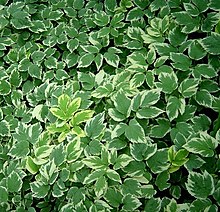Aegopodium podagraria: Difference between revisions
m robot Adding: stq:Gäisekool |
Monsterparty (talk | contribs) m Added Edible Uses, created subheadings for invasive habit, wildlife, and ornamental use |
||
| Line 17: | Line 17: | ||
is in the carrot family ([[Apiaceae]]) that grows in shady places. It is sometimes also cited as "ground elder", though this format invites confusion by suggesting it is a species of [[Elderberry|elder]] (''Sambucus''), an unrelated genus. It is also known as '''herb gerard''', '''bishop's weed''', '''goutweed''', and '''snow-in-the-mountain'''. It is the [[type species]] of the genus ''[[Aegopodium]]''. |
is in the carrot family ([[Apiaceae]]) that grows in shady places. It is sometimes also cited as "ground elder", though this format invites confusion by suggesting it is a species of [[Elderberry|elder]] (''Sambucus''), an unrelated genus. It is also known as '''herb gerard''', '''bishop's weed''', '''goutweed''', and '''snow-in-the-mountain'''. It is the [[type species]] of the genus ''[[Aegopodium]]''. |
||
==Edible Uses== |
|||
The tender [[Leaf|leaves]] have been used as a spring [[leaf vegetable]], much as [[spinach]] was used. It has also been used to treat [[gout]] and [[arthritis]]. The plant is said to have been introduced into [[England]] by the [[Ancient Rome|Romans]] and into [[Northern Europe]] by [[monk]]s. |
The tender [[Leaf|leaves]] have been used as a spring [[leaf vegetable]], much as [[spinach]] was used. It has also been used to treat [[gout]] and [[arthritis]]. The plant is said to have been introduced into [[England]] by the [[Ancient Rome|Romans]] as a food plant and into [[Northern Europe]] by [[monk]]s. |
||
It is best picked from when it appears (as early as February in the UK) through to just before it flowers (May to June). If it is picked after this point it takes on an unusual taste and has a horrible laxative effect! However you can stop the plant from flowering by pinching out the flowers, this will ensure the plant remains edible if used more sparingly as a pot herb.<ref>http://www.edible-plants.com/groundelder.html</ref> |
|||
==Invasive Habit== |
|||
In some areas, this plant is considered among the worst of weeds, as it readily spreads over large areas of ground by underground [[rhizome]]s. It is extremely invasive, and crowds out native species. The smallest piece of rhizome left in the ground will quickly form a sturdy new plant, followed by many more. |
In some areas, this plant is considered among the worst of weeds, as it readily spreads over large areas of ground by underground [[rhizome]]s. It is extremely invasive, and crowds out native species. The smallest piece of rhizome left in the ground will quickly form a sturdy new plant, followed by many more. |
||
If a small plant finds its way into an ornamental perennial flower garden it will spread with vigor, resist all attempts at eradication, and make continued ornamental gardening there very difficult. |
If a small plant finds its way into an ornamental perennial flower garden it will spread with vigor, resist all attempts at eradication, and make continued ornamental gardening there very difficult. |
||
==Ornamental Use== |
|||
| ⚫ | |||
A variegated form is grown as an [[ornamental plant]], though with the advice to keep it isolated. |
|||
==Importance To Wildlife== |
|||
| ⚫ | |||
__NOTOC__ |
__NOTOC__ |
||
Revision as of 21:27, 25 July 2009
| Ground-elder | |
|---|---|

| |
| Scientific classification | |
| Kingdom: | |
| (unranked): | |
| (unranked): | |
| (unranked): | |
| Order: | |
| Family: | |
| Genus: | |
| Species: | A. podagraria
|
| Binomial name | |
| Aegopodium podagraria | |
The ground-elder (Aegopodium podagraria) is in the carrot family (Apiaceae) that grows in shady places. It is sometimes also cited as "ground elder", though this format invites confusion by suggesting it is a species of elder (Sambucus), an unrelated genus. It is also known as herb gerard, bishop's weed, goutweed, and snow-in-the-mountain. It is the type species of the genus Aegopodium.
Edible Uses
The tender leaves have been used as a spring leaf vegetable, much as spinach was used. It has also been used to treat gout and arthritis. The plant is said to have been introduced into England by the Romans as a food plant and into Northern Europe by monks. It is best picked from when it appears (as early as February in the UK) through to just before it flowers (May to June). If it is picked after this point it takes on an unusual taste and has a horrible laxative effect! However you can stop the plant from flowering by pinching out the flowers, this will ensure the plant remains edible if used more sparingly as a pot herb.[1]
Invasive Habit
In some areas, this plant is considered among the worst of weeds, as it readily spreads over large areas of ground by underground rhizomes. It is extremely invasive, and crowds out native species. The smallest piece of rhizome left in the ground will quickly form a sturdy new plant, followed by many more.
If a small plant finds its way into an ornamental perennial flower garden it will spread with vigor, resist all attempts at eradication, and make continued ornamental gardening there very difficult.
Ornamental Use
A variegated form is grown as an ornamental plant, though with the advice to keep it isolated.
Importance To Wildlife
It is used as a food plant by the larvae of some species of Lepidoptera including dot moth, grey dagger and grey pug.
Images
-
Variegated ground-elder in flower
-
Ground-elder on the wayside
-
A single umbel
-
Leaves
-
Stem profile - there is no toxic look-alike with a triangular profile.
-
Aegopodium podagraria.
External links
Herbal information
- Goutweed (Aegopodium podagraria) Mrs. Grieve's "A Modern Herbal" at Botanical.com






